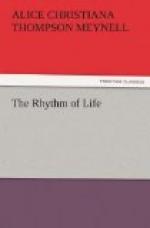Men said that he led a dilettante life. They reproached him with the selflessness that made him somewhat languid. Others, they seemed to aver, were amateurs at this art or that; he was an amateur at living. So it was, in the sense that he never grasped at happiness, and that many of the things he had held slipped from his disinterested hands. So it was, too, in this unintended sense; he loved life. How should he not have loved a life that his living made honourable? How should he not have loved all arts, in which his choice was delicate, liberal, instructed, studious, docile, austere? An amateur man he might have been called, too, because he was not discomposed by his own experiences, or shaken by the discovery which life brings to us-that the negative quality of which Buddhism seems to accuse all good is partaken by our happiness. He had always prayed temperate prayers and harboured probable wishes. His sensibility was extreme, but his thought was generalised. When he had joy he tempered it not in the common way by meditation upon the general sorrow but by a recollection of the general pleasure. It was his finest distinction to desire no differences, no remembrance, but loss among the innumerable forgotten. And when he suffered, it was with so quick a nerve and yet so wide an apprehension that the race seemed to suffer in him. He pitied not himself so tenderly as mankind, of whose capacity for pain he was then feelingly persuaded. His darkening eyes said in the extreme hour: ‘I have compassion on the multitude.’
THE SUN
Nowhere else does the greater light so rule the day, so measure, so divide, so reign, make so imperial laws, so visibly kindle, so immediately quicken, so suddenly efface, so banish, so restore, as in a plain like this of Suffolk with its enormous sky. The curious have an insufficient motive for going to the mountains if they do it to see the sunrise. The sun that leaps from a mountain peak is a sun past the dew of his birth; he has walked some way towards the common fires of noon. But on the flat country the uprising is early and fresh, the arc is wide, the career is long. The most distant clouds, converging in the beautiful and little-studied order of cloud-perspective (for most painters treat clouds as though they formed perpendicular and not horizontal scenery), are those that gather at the central point of sunrise. On the plain, and there only, can the construction—but that is too little vital a word; I should rather say the organism—the unity, the design, of a sky be understood. The light wind that has been moving all night is seen to have not worked at random. It has shepherded some small flocks of cloud afield and folded others. There’s husbandry in Heaven. And the order has, or seems to have, the sun for its midst. Not a line, not a curve, but confesses its membership in a design declared from horizon to horizon.




